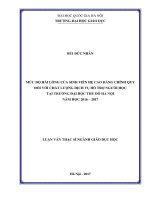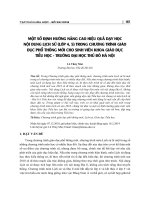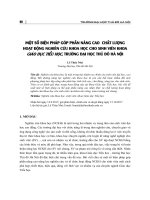Ứng dụng hệ thống mã nguồn mở xây dựng hệ thống đánh giá tự động kỹ năng lập trình tại trường Đại học Thủ đô Hà Nội
Bạn đang xem bản rút gọn của tài liệu. Xem và tải ngay bản đầy đủ của tài liệu tại đây (740.4 KB, 9 trang )
SCIENTIFIC JOURNAL OF HANOI METROPOLITAN UNIVERSITY − VOL.56/2022
5
APPLY OPEN RESOURCE CODE SYSTEM TO
AUTOMATICALLY PRODUCE PROGRAMMING
SKILLS AT HANOI METROPOLITAN UNIVERSITY
Nguyen Quoc Tuan(*), Hoang Thi Mai, Truong Duc Phuong, Le Chi Chung
Hanoi Metropolitan University
Abstract: The article proposes the development of an automatic assessment system for
programming skills for students in information technology at Hanoi Metropolitan
University. This system supports the organization of the exam to assess programming skills
and allows applicants to take the exam online via the Internet or Local Area Network
(LAN). The system accepts applicants' work and automatically scores completely
objectively on predefined test sets, without being influenced by subjective opinions or the
examiner's psychology.
Keywords: CMS, Ubuntu operating system, contest management system
Received 10 December 2021
Revised and accepted for publication 26 January 2022
(*) Email:
1. INTRODUCTION
Programming languages are an important subject within the computer industry.
Learning to program on a computer is difficult, demanding students to do much effort and
work. Students have to do a lot of exercises and write a lot of programs to enhance their
programming skills. To improve the programming skills of students, an effective and widely
utilized method is to evaluate through programming tests. Students assigned to a problem
need to construct a program to process the input and output data according to the objective
of the problem. Instructors will provide experimental input data and compare program
outputs with examples of output values consistent with the purpose of the problem. The
efficiency of the problem is determined by the accuracy of the processing results and the
processing time of the data...
With manual grading, the lecturer takes a lot of time and it is difficult to check and
correct all students in a class. Especially, in the period when students are just learning to
program, a program can make a lot of mistakes, requiring the lecturer to check and correct
6
HANOI METROPOLITAN UNIVERSITY
them many times. With the current situation of over 30 students/practice groups, it is very
difficult to guide and shape practice skills.
With each practice in programming, it is necessary to satisfy the following properties:
correctness, efficiency, and universality. However, students often do not argue all cases of
the problem or do not know whether their implementation algorithm has achieved efficiency
or not. Therefore, to support students to self-check their results in the learning process,
practice programming skills while minimizing the time and effort of lecturers, we propose
to build a grading system automatic programming. The system receives student work and
automatically scores completely objectively on pre-built test sets. Then the system will
display the results of the student's work.
2. CONTENT
2.1. Theoretical and practical basis for the construction of an automatic evaluation
system for programming competencies at the Faculty of Science and Technology, Hanoi
Metropolitan University
For students in the Information Technology sector, the evaluation of algorithm quality in
terms of program runtime, efficiency, and ability to cover difficult situations cannot be
comprehensively assessed through analysis, program. Therefore, to support students to selfcheck their results in the learning process, practical programming skills while minimizing the
time and effort of lecturers, building an automatic grading system Teaching support is essential.
The main advantages of using automatic grading software over traditional grading are:
1. Automate scoring operations, avoid confusion when scoring and ranking.
2. The scoring process is completely objective on pre-built test suites, unaffected by
subjective opinions or the judge's psychology.
3. The printing of tables, retrieving the statistics is done completely automatically and
accurately. Those statistics can be integrated into other software to make reports and draw
lessons for the following exams.
4. After the exam is over, the data for the exam can be published and the other
candidates can practice on the tests and then use the automatic grading program to self-assess
instead of having to invite a panel of judges, to re-dot.
With the development of information technology, the process of passing the test can be
done entirely through the computer network environment, the use of these systems is often
referred to as the test environment, program. There has been much different software to do
this work such as Codeforce, SPOIJ, DMOJ, SPHERE, Themis, etc. This software has been
deployed to serve the computer Olympiad in the world and the Informatics Olympiad in
water as well as self-learning programming for users.
For the university teaching environment, the programming test environment will greatly
support the learning and self-study process of programming languages and algorithms of
students because students can access a library of exercises, very large with all difficulty
SCIENTIFIC JOURNAL OF HANOI METROPOLITAN UNIVERSITY − VOL.56/2022
7
levels. The assessment process is also automatic, so that students can self-study, improve
their programming ability as well as test the algorithms they have learned. Students can
register to these servers to participate in the testing and evaluation process.
In the training program of the information technology industry, the total amount of
knowledge of the whole course has 130 credits, of which the number of programming-related
modules accounts for 18 modules of 46 credits, accounting for 35.4% of the total number of
courses. courses. These modules are distributed from the base of the industry and have a
strong focus on the major. With such a large number of programming subjects, they are a
big challenge for students of information technology.
The knowledge foundation of programming subjects is based on mathematics and
students' logical thinking ability. In addition, to learn programming well, students need to
have love and passion, practice as much as possible. However, the actual source of students
entering the IT industry of the school is only in the middle. Therefore, students' ability to
absorb, self-discipline in learning, and passion for the field of study are still not high.
For lecturers of information technology, the number of lecturers is 7, of which each
semester has to undertake a large amount of teaching, especially the number of students in
each class is quite large, so the close attention Getting to each student is quite difficult. In
the face of such situations, in the process of teaching programming subjects and assessing
the subject, the lecturers of the information technology industry have used some supporting
tools. For students' daily practice, use Codefun to increase their programming ability and
passion for programming. For the evaluation of the end of programming courses, the faculty
uses Themis software to automatically grade students' work.
However, the application of test environments on international systems in training information
technology students at the Hanoi Metropolitan University is not appropriate because:
1.
2.
3.
4.
Not being proactive and controlling the servers as well as the test results[4].
Existing systems with large student populations cannot be exploited[4].
The language of the title description is not suitable for students[4].
Test data and answers are served separately for each system[4].
With the above problems, we have come up with a solution to build an environment for
self-assessment of the correctness of a computer program. Based on the program running
with different data situations, when compared with the sample results, it will quickly evaluate
the correctness of the program. This is a highly feasible solution, capable of solving the
above problems.
Build an automatic assessment system for programming skills so that teachers can mark
students' papers automatically. Thereby, contributing to increasing the effectiveness of
teaching programming subjects. Instructors will put exercises, test sets into the system and
see the results of students' work. Students will enter the system, take the test, program it in
an external editor and then submit it to the system. The system will automatically grade the
test by entering each test set and comparing them in turn, output results. Then the system
8
HANOI METROPOLITAN UNIVERSITY
will display the combined results of the work. If the student's work has errors, the system
will notify the details of the error. The system supports students very well in the process of
learning programming, helping students improve their programming skills and algorithmic
thinking skills.
2.2. Building an automatic assessment system for programming skills
2.2.1. Select evaluation environment
Exam Management System (CMS) is an open-source marking system that has been used
in many international programming exams.
CMS can conduct programming, testing on languages: Java, Pascal, Python2, Haskell,
PHP, C, C++, C#, Python3, Rust.
This system has the following basic properties:
1. Secure: even though the main security measure for a contest is to isolate the
contestants and the grading networks, obviously there must be at least one point of contact
between the two; this must give the fewest possible ways of attacking the system.
2. Robust: an error or a critical condition in one part of the system must not take down
the whole system; hot-swapping of services and machines is not an exceptional condition
but a standard procedure; the coherence of the state of the contest must always be ensured.
3. Developed for the community: CMS must be easily accessible, free, and open-source
(it is licensed under the GNU Affero General Public License (Free Software Foundation,
Inc., 2007)); feature requests, bug reports, and patches must be considered and applied
whenever possible and without long delays; it must support localization of the contestant's
interface.
4. Extensible: new or rare task types and scoring methods must be easy to implement
in the form of plug-ins; currently based on the current competition rules for the IOI, CMS
should leave the possibility of reflecting the modifications of such rules by future hosts.
5. Adaptable: CMS must not interfere with the first two points listed previously for
organizing a contest, namely it must not mandate a minimum number of grading machines,
or special network configurations (apart from the ones that prevent security issues), and must
not require a particular method of preparing the tasks for the contest.
6. Usable: CMS must be well-documented for contests administrators, developers, and
contestants, and it must not require insights into the internals of the system for running a
contest.
2.2.2. Overview of the CMS system
CMS is an open-source system written in python. CMS includes many services, services
can be installed distributed on many servers[2].
1. LogService: Receiving, aggregating, and displaying all the logs of the system
2. Worker: Running compilations and evaluations of submissions in a safe
environment.
SCIENTIFIC JOURNAL OF HANOI METROPOLITAN UNIVERSITY − VOL.56/2022
9
3. EvaluationService: Maintaining the queue of the jobs to be assigned to the Workers.
4. ScoringService: Transforming the evaluation results into scores, and communicating
them to the live rankings.
5. Checker: Calling the heartbeat function of all the services.
6. ResourceService: Collecting resource usage information about the machine in which
it is running, and starting all the services on a machine.
7. ContestWebServer: Serving web pages to the contestants, accepting submissions,
and providing feedback.
Fig 1: Services and their interactions in CMS
8. AdminWebServer: Serving web pages to the administrators, configuring and
managing the contests.
9. CMS is managed in a distributed form (many modules), with many utility services
(services), and can be managed on many computers. At runtime, utility services can adjust
to a major competition.
2.2.3. System requirements and settings
Requirements: The system is installed on Ubuntu 18.04 operating system platform.
System settings:
1. Install library packages: PostgreSQL, gettext, Python, setuptools, Tornado, Psycopg,
simplejson, SQLAlchemy, psutil, PyCrypto, BeautifulSoup, …[3]
10
HANOI METROPOLITAN UNIVERSITY
2. Download and install CMS at: />3. Setting Up CMS:[3]
1. Step 1: Install the necessary packages to operate the CMS system
1. build-essential openjdk-8-jdk-headless fp-compiler \postgresql postgresql-client
python3.6 cppreference-doc-en-html \cgroup-lite libcap-dev zip
2. python3.6-dev libpq-dev libcups2-dev libyaml-dev \libffi-dev python3-pip
1. Step 2: Install CMS services
1. sudo python3 prerequisites.py install
2. sudo pip3 install -r requirements.txt
3. sudo python3 setup.py install
2. Step 3: Access the database to create an account and password
3. Step 4: Configure CMS
1. Running CMS:[3]
1.
Step 1: Run the services with admin rights
1.
2.
3.
4.
5.
6.
7.
8.
9.
10.
11.
12.
sudo su /etc/init.d/postgresql restart
nohup cmsAdminWebServer >>
nohup cmsResourceService >>
nohup cmsRankingWebServer >>
nohup cmsWorker >>
nohup cmsScoringService >>
nohup cmsEvaluationService >>
nohup cmsProxyService >>
Step 2: Initialize service for candidates
sudo su –
cmsContestWebServer
2.3. Configuration for the contest
The site for the administrator has the form of an IP address: 8889, for example,
http://127.0.0.1:8889/ (local server address)
1. Contests section: Create a name for the contest
2. Tasks section: Create a question
3. Users section: Create a list of candidates
2.4. Systematic application in assessing programming skills for students of Faculty of
Science and Technology, Hanoi Metropolitan University
The system has been tested and operational since November 2021
The main results obtained are as follows:
SCIENTIFIC JOURNAL OF HANOI METROPOLITAN UNIVERSITY − VOL.56/2022
11
Fig 2: Addmin page
1. Supports programming languages, including a full range of popular programming
languages such as Pascal, C, C++, C#, Java, Python, PHP, Haskell, Rust, …
1. Created more than 70 topics on the system, including topics and test cases.
2. There are more than 170 members who are students of the Faculty of Science and
Technology.
3. Organized 2 programming Olympiads during Science and Technology Day of the
Faculty. Taking place in 2 days is November 25, 2021, and December 4, 2021.
Fig 3: Result of round
12
HANOI METROPOLITAN UNIVERSITY
Fig 4: Result of round 2
Comment:
1. The system has received enthusiastic participation from students
2. The system has supported well for testing students' programming skills. The use of
the system will help improve the quality of training and students' programming skills.
3. The system helps Instructors save time on correcting errors for students. Help
Instructors focus on completing assignments and test cases to improve the quality of training
for students.
4. The system assesses students' programming skills completely objective and effective.
5. The system can operate on the internet or in the LAN environment.
3. CONCLUSION
The article has solved the problem of assessing students' programming by developing
an automatic assessment system for programming skills. The system has full functions:
contest management; managing topics and test cases; managing the list of candidates;
managing test results of candidates; compilation and grading; candidate ranking.
The system has been installed and operating stably at :8889. The
system initially worked well and proved to be effective in automatically assessing students'
programming skills. The system helps students have a daily practice environment to improve
their programming skills and thinking. Moreover, the system ensures an efficient and public
assessment of the results of students' programming courses.
It is recommended to continue to build a good-classified set of exercises and build
quality test cases to ensure the correctness of the problem.
SCIENTIFIC JOURNAL OF HANOI METROPOLITAN UNIVERSITY − VOL.56/2022
13
REFERENCES
1. Bayer, M. (2005), SQLAlchemy: The Database Toolkit for Python, retrieved from
/>2. Boscariol, M., Maggiolo, S., Mascellani, G. (2010), CMS, a Contest Management System,
retrieved from />3. Stefano MAGGIOLO, Giovanni MASCELLANI (2012), “Introducing CMS: A Contest
Management System”, Olympiads in Informatics, Vol. 6, 86–99.
4. Nguyễn Xuân Nghĩa, Phạm Xuân Tích (2018), “Xây dựng hệ thống đánh giá trực tuyến kĩ năng
lập trình của sinh viên ngành điện và công nghệ thông tin trường đại học giao thơng vận tải”, Tạp
chí Giáo dục, Số 442 (Kì 2 - 11/2018), tr. 61-64.
ỨNG DỤNG HỆ THỐNG MÃ NGUỒN MỞ XÂY DỰNG
HỆ THỐNG ĐÁNH GIÁ TỰ ĐỘNG KỸ NĂNG LẬP TRÌNH
TẠI TRƯỜNG ĐẠI HỌC THỦ ĐƠ HÀ NỘI
Tóm tắt: Bài báo trình bày nội dung nghiên cứu về xây dựng hệ thống đánh giá tự động kỹ
năng lập trình cho sinh viên ngành Công nghệ thông tin Trường Đại học Thủ đô Hà Nội.
Hệ thống hỗ trợ các công tác tổ chức kì thi đánh giá kĩ năng lập trình và cho phép thí sinh
tham gia thi trực tuyến qua Internet hoặc mạng nội bộ (LAN). Hệ thống thu nhận bài làm
của thí sinh và tự động chấm điểm hoàn toàn khách quan trên các bộ test được xây dựng
từ trước, không chịu ảnh hưởng bởi ý kiến chủ quan hay tâm lý của người chấm.
Từ khoá: CMS, hệ điều hành Ubuntu, hệ thống quản lý cuộc thi.









